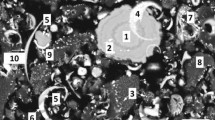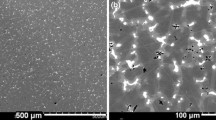Abstract
In order to recover gold and silver from anode slimes containing Cu, Ni, Sn, and Zn, an integrated hydrometallurgical process consisting of leaching, solvent extraction, and cementation was developed. All the metals together with 10% of Ag(I) were dissolved by the mixture of HCl and H2O2 at the optimum conditions. Separation of Au (III) together with Sn (II) was performed by Cyanex 272 from the leaching solution with two-stage counter current extraction. Stripping of Au (III) and Sn (II) from the loaded organic phase was sequentially carried out by NH4Cl and NaOH. Cu (II) in the raffinate after Au (III) extraction was separated by LIX 63 with three-stage counter current extraction. Pure Cu (II) solution was recovered from the loaded LIX 63 by stripping with dilute HCl solution. Ag powders with extra high purity were obtained by cementation with copper sheet from the raffinate after Cu (II) separation. Au (III) (99.3%) and 96.8% of Sn (II) were recovered by extraction, and purity of Au (III) and Sn (II) stripping solutions was found to be 99.99%. Au powders with extra high purity were directly synthesized by adding ascorbic acid solution into the NH4Cl stripping solution.












Similar content being viewed by others
References
U.S. Geological Survey (2018) Mineral commodity summaries 2018: U.S. Geological Survey, 200 p. https://doi.org/10.3133/70194932
Dehghanpoor MH, Zivdar M, Torabi M (2016) Extraction of copper and gold from anode slime of Sarcheshmeh Copper Complex. J South Afr Inst Min Metall 116(7):1153–1157. https://doi.org/10.17159/2411-9717/2016/v116n12a9
Hait J, Jana RK, Sanyal SK (2013) Processing of copper electrorefining anode slime: a review. Miner Process Extract Metall 118(4):240–252. https://doi.org/10.1179/174328509x431463
Lu D, Chang Y, Yang H, Xie F (2015) Sequential removal of selenium and tellurium from copper anode slime with high nickel content. Trans Nonferrous Met Soc China 25(4):1307–1314. https://doi.org/10.1016/s1003-6326(15)63729-3
Ding Y, Zhang S, Liu B, Li B (2017) Integrated process for recycling copper anode slime from electronic waste smelting. J Clean Prod 165:48–56. https://doi.org/10.1016/j.jclepro.2017.07.094
Kilic Y, Kartal G, Timur S (2013) An investigation of copper and selenium recovery from copper anode slimes. Int J Miner Process 124:75–82. https://doi.org/10.1016/j.minpro.2013.04.006
Nagai H, Shibata E, Nakamura T (2017) Development of methods for concentration and dissolution of Rh and Ru from copper slime. Hydrometallurgy 169:282–289. https://doi.org/10.1016/j.hydromet.2017.01.004
Han J, Liang C, Liu W, Qin W, Jiao F, Li W (2017) Pretreatment of tin anode slime using alkaline pressure oxidative leaching. Sep Purif Technol 174:389–395. https://doi.org/10.1016/j.seppur.2016.10.056
Xing W, Lee M (2017) Leaching of gold and silver from anode slime with a mixture of hydrochloric acid and oxidizing agents. Geosyst Eng 20(4):216–223. https://doi.org/10.1080/12269328.2017.1278728
Xu B, Yang Y, Li Q, Yin W, Jiang T, Li G (2016) Thiosulfate leaching of Au, Ag and Pd from a high Sn, Pb and Sb bearing decopperized anode slime. Hydrometallurgy 164:278–287. https://doi.org/10.1016/j.hydromet.2016.06.011
Li J, Miller JD (2006) A review of gold leaching in acid thiourea solutions. Miner Process Extr Metall Rev 27(3):177–214. https://doi.org/10.1080/08827500500339315
Viñals J, Juan E, Ruiz M, Ferrando E, Cruells M, Roca A, Casado J (2006) Leaching of gold and palladium with aqueous ozone in dilute chloride media. Hydrometallurgy 81(2):142–151. https://doi.org/10.1016/j.hydromet.2005.12.004
Lee HY, Kim SG, Oh JK (2013) Cementation behavior of gold and silver onto Zn, Al and Fe powders from acid thiourea solutions. Can Metall Q 36(3):149–155. https://doi.org/10.1179/cmq.1997.36.3.149
Chaparro M, Munive G, Guerrero P, Parga JR, Vazquez V, Valenzuela JL (2015) Gold adsorption in thiosulfate solution using anionic exchange resin. J Multidiscip Eng Sci Technol 2(8):2159–2163
Sadeghi N, Alamdari EK (2016) Selective extraction of gold (III) from hydrochloric acid–chlorine gas leach solutions of copper anode slime by tri-butyl phosphate (TBP). Trans Nonferrous Met Soc China 26(12):3258–3265. https://doi.org/10.1016/s1003-6326(16)64459-x
Kononova ON, Melnikov AM, Borisova TV (2012) Simultaneous sorption recovery of platinum and rhodium from sulfate–chloride solutions. Hydrometallurgy 117-118:101–107. https://doi.org/10.1016/j.hydromet.2012.02.014
Safarzadeh MS, Horton M, Rythoven ADV (2017) Review of recovery of platinum group metals from copper leach residues and other resources. Miner Process Extr Metall Rev 39(1):1–17. https://doi.org/10.1080/08827508.2017.1323745
Li D, Guo X, Xu Z, Xu R, Feng Q (2016) Metal values separation from residue generated in alkali fusion-leaching of copper anode slime. Hydrometallurgy 165:290–294. https://doi.org/10.1016/j.hydromet.2016.01.021
Xing W, Lee M, Senanayake G (2018) Recovery of metals from chloride leach solutions of anode slimes by solvent extraction. Part I: recovery of gold with Cyanex 272. Hydrometallurgy 180:58–64
Xing W, Lee M, Senanayake G (2018) Recovery of metals from chloride leach solutions of anode slimes by solvent extraction. Part II: recovery of silver and copper with LIX 63 and Alamine 336. Hydrometallurgy 180:49–57
Rüşen A, Topçu MA (2017) Optimization of gold recovery from copper anode slime by acidic ionic liquid. Korean J Chem Eng 34(11):2958–2965. https://doi.org/10.1007/s11814-017-0200-4
Nikoloski AN, Ang K-L, Li D (2015) Recovery of platinum, palladium and rhodium from acidic chloride leach solution using ion exchange resins. Hydrometallurgy 152:20–32. https://doi.org/10.1016/j.hydromet.2014.12.006
Xing W, Lee M, Choi S (2018) Separation of Ag(I) by ion exchange and cementation from a raffinate containing Ag(I), Ni(II) and Zn(II) and traces of Cu(II) and Sn(II). Processes 6(8):112–126. https://doi.org/10.3390/pr6080112
Malassis L, Dreyfus R, Murphy RJ, Hough LA, Donnio B, Murray CB (2016) One-step green synthesis of gold and silver nanoparticles with ascorbic acid and their versatile surface post-functionalization. RSC Adv 6(39):33092–33100. https://doi.org/10.1039/c6ra00194g
Ji X, Song X, Li J, Bai Y, Yang W, Peng X (2007) Size control of gold nanocrystals in citrate reduction: the third role of citrate. J Am Chem Soc 129:13939–13948
Zhang Z, Wu Y (2010) Investigation of the NaBH4-induced aggregation of Au nanoparticles. Langmuir 26(12):9214–9223. https://doi.org/10.1021/la904410f
Xing W, Lee M (2019) Recovery of gold(III) from the stripping solution containing palladium(II) by ion exchange and synthesis of gold particles. J Ind Eng Chem 69:255–262
Liu Y, Lee M (2016) Regeneration of a binary mixture of Cyanex 272 and Alamine 336 for the solvent extraction of rare earths elements by treatment with sodium hydroxide solution. J Mol Liq 219:411–416. https://doi.org/10.1016/j.molliq.2016.03.055
Funding
This work was supported by National Research Foundation of Korea (2018R1D1A1B07044951).
Author information
Authors and Affiliations
Corresponding author
Ethics declarations
Open access
This article is distributed under the terms of the Creative Commons Attribution License which permits any use, distribution, and reproduction in any medium, provided the original author(s) and the source are credited.
Additional information
Publisher’s note
Springer Nature remains neutral with regard to jurisdictional claims in published maps and institutional affiliations.
Rights and permissions
About this article
Cite this article
Xing, W.D., Lee, M.S. Development of a hydrometallurgical process for the recovery of gold and silver powders from anode slime containing copper, nickel, tin, and zinc. Gold Bull 52, 69–77 (2019). https://doi.org/10.1007/s13404-019-00254-0
Received:
Accepted:
Published:
Issue Date:
DOI: https://doi.org/10.1007/s13404-019-00254-0




